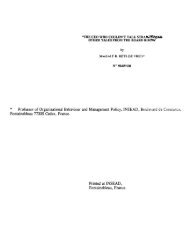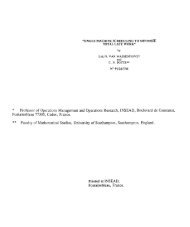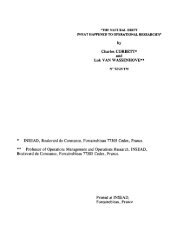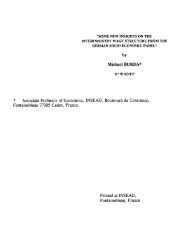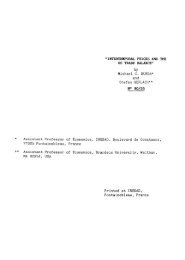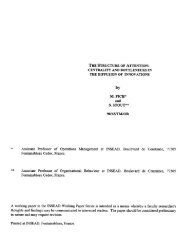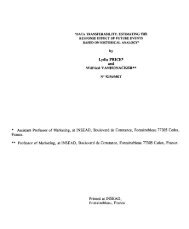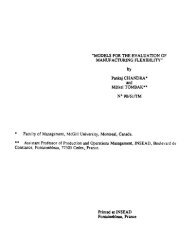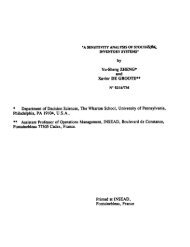* Assistant Professor of Operations Management at INSEAD ...
* Assistant Professor of Operations Management at INSEAD ...
* Assistant Professor of Operations Management at INSEAD ...
You also want an ePaper? Increase the reach of your titles
YUMPU automatically turns print PDFs into web optimized ePapers that Google loves.
price charged by an internal service facility as<br />
ow<br />
p: = E for n = 1, , N.<br />
j.i 0An<br />
In Theorem 3.2, they propose a contract <strong>of</strong> the form qn (7-„,) = Anrm BrZ<br />
such th<strong>at</strong> E qn(rn) = p: and show th<strong>at</strong> this contract is incentive-comp<strong>at</strong>ible<br />
(all users tell the truth) and thus implements the equilibrium.<br />
From equ<strong>at</strong>ions (2), the equilibrium price dict<strong>at</strong>ed by the market in the<br />
present model, given th<strong>at</strong> the firms put out the equilibrium quantities, is<br />
, ow;<br />
Pn = E ciAjTjTn- AnPni (An) = q i: — AnPn (An) for n = 1, , N. (5)<br />
=1<br />
Observe th<strong>at</strong> the q: in equ<strong>at</strong>ion (5) has the same functional form as the<br />
Mendelson and Whang price The extra term in equ<strong>at</strong>ion (5) can be<br />
interpreted as the decrease in revenue associ<strong>at</strong>ed with price deterior<strong>at</strong>ion<br />
caused by a volume increase <strong>of</strong> one unit. Therefore, the duopoly equilibrium<br />
price is larger than the welfare maximizing price (even though a volume<br />
reduction <strong>of</strong>fsets part <strong>of</strong> the increase caused by the revenue term).<br />
Because <strong>of</strong> the extra revenue term, Mendelson and Whang's incentive<br />
pricing scheme cannot be used directly by the duopolists. However, it is<br />
possible to construct a generaliz<strong>at</strong>ion <strong>of</strong> the Mendelson and Whang scheme<br />
th<strong>at</strong> implements the duopoly equilibrium and is incentive-comp<strong>at</strong>ible. Reestablishing<br />
the equilibrium requires th<strong>at</strong> the firms put out the equilibrium<br />
quantities given by equ<strong>at</strong>ions (2) and then charge a service-time dependent<br />
price qn(rm ), whose expect<strong>at</strong>ion for the customer is the equilibrium price set<br />
by the market.<br />
Proposition 2 Consider the contract<br />
where:<br />
1<br />
qn(rm.) = Anrm + — (B —<br />
2<br />
ran rainke(i...N)1{n}<br />
)rm2 777_ 111„<br />
„ (Tin _1)2 AnP,',(An), (6)<br />
mn tin<br />
11, ).21 0,<br />
Mn c rnax kE{1...N} { –Ak Pik(Ak) AnP, (An)} 10,<br />
and An and B are the constants defined in<br />
Mendelson and Whang.<br />
not<strong>at</strong>ion to m<strong>at</strong>ch the not<strong>at</strong>ion used in the present model.<br />
5 For completeness, the constants are presented in the pro<strong>of</strong>.<br />
13



